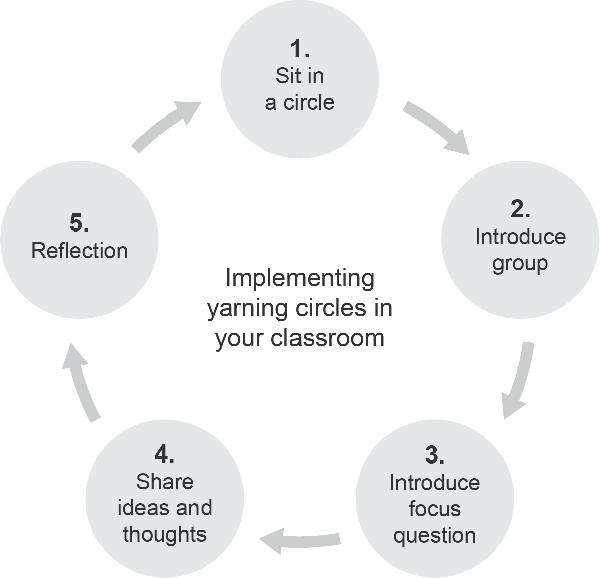The use of a yarning circle (or dialogue circle) is an important process within Aboriginal culture and Torres Strait Islander culture. It has been used by Indigenous peoples from around the world for centuries to learn from a collective group, build respectful relationships, and to preserve and pass on cultural knowledge.
By using yarning circles as a teaching and learning strategy, students’ understanding of Aboriginal and Torres Strait Islander knowledge and ways of working are enhanced. This strategy is suitable for students across all phases of schooling.
Building respectful relationships
A yarning circle is a harmonious, creative and collaborative way of communicating to:
encourage responsible, respectful and honest interactions between participants, building trusting relationships
foster accountability and provide a safe place to be heard and to respond
promote student–student interactions and student–school–community connectedness
enrich learning experiences for students.
In some instances, the ‘no language’ method can be applied to the yarning circle. This method originated from watching elders. Very few questions are asked; the primary method of learning is through observation. The Australian Institute for Teaching and School Leadership have developed a video expanding on the ‘no language’ method of learning.
Implementing yarning circles in your classroom
A yarning circle is usually initiated or hosted by an individual — a teacher, a student, or a visitor. Yarning circles can take a number of formats but the following guidelines generally apply when initiating a yarning circle.
Sit in a circle: Participants sit in a circle and are encouraged to actively listen to others’ views. Participants should understand that they are all considered equal within the circle and that there is no hierarchy.
Introduce the group: The host invites participants to introduce themselves and share something about themselves.
Introduce focus questions: Yarning circles can be undertaken for many reasons. The host introduces the purpose of the yarning circle or the focus question to participants.
Share ideas and thoughts: The host encourages participants to take turns to talk and to promote reciprocal sharing and learning. Time can be allocated for participants to write or draw their thoughts after each person speaks. The host could provide butcher’s paper in the middle of the circle for participants to record their thoughts, or hold the circle outside so participate can draw their thoughts in the dirt.
Reflect: Resolve any actions or issues identified by the yarning circle, or agree to follow up in future yarning circles.
Yarning circles diagram

A yarning circle can be used as a learning tool to enrich and promote the shared knowledge of the group. It builds on existing relationships in a respectful and meaningful way.
Resources
Let’s Have A Yarn With Yarn®, The Yarning Circle
This program captures the ethos of Aboriginal yarning circles and is transferable to any situation.Yarning circles in the literacy classroom, Mills 2013 (PDF)
This article explains how the speaking and listening practice of yarning circles can be used for literacy in the classroom.Creative and Productive Pedagogy Activities, 8 ways
This website provides background information about the pedagogy of yarning and storytelling for Aboriginal cultures.The no language method, The Australian Institute for Teaching and School Leadership (AITSL)
This video expands on the ‘no language’ method of learning.


